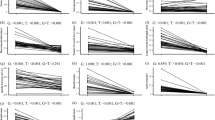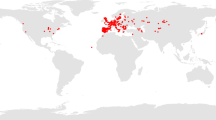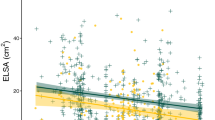Abstract
The study of the association between fitness and reaction norms is of primary importance given the hypothesized role for phenotypic plasticity in shaping evolutionary patterns: in microevolution, as one mechanism for maintaining genetic variation, and in macroevolution, as a means of generating phenotypic novelties. In a glasshouse experiment, we investigated variation in reaction norms to nutrient availability in populations of Arabidopsis thaliana, and the relationship between this variation and reproductive fitness. We found evidence for across-treatment directional selection on the means for leaf number, flowering time, plant height, branching and growth rate; across-treatment stabilizing selection was detected for growth rate; and across-treatment disruptive selection was significant for leaf number. We also uncovered selection on the plasticity of some traits: directional for the plasticity of branching, and stabilizing for the plasticity of both branching and growth rate. When the two environments were considered separately, directional selection for height was detected under low nutrients; under high nutrients, we found evidence for directional selection on leaf number and height, and for disruptive selection on flowering time. The genetic correlation between a trait's expression in one environment and its expression in the alternate environment was positive and highly significant only for flowering time and growth rate. A principal components analysis revealed possible constraints on future selection responses, because of correlations among character means and among character plasticities.
Similar content being viewed by others
Article PDF
References
Abbott, R J, and Gomes, M F. 1989. Population genetic structure and outcrossing rate of Arabidopsis thaliana (L.) Heynh. Heredity, 62, 411–418.
Alexander, R MCN. 1991. Apparent adaptation and actual performance. Evol Biol, 25, 357–373.
Bell, G. 1992. The ecology and genetics of fitness in Clamydomonas. V. The relationship between genetic correlation and environmental variance. Evolution, 46, 561–565.
Bradshaw, A D. 1965. Evolutionary significance of phenotypic plasticity in plants. Adv Genet, 13, 115–155.
De Jong, G. 1994. The fitness of fitness concepts and the description of natural selection. Q Rev Biol, 69, 3–29.
De Jong, G. 1995. Phenotypic plasticity as a product of selection in a variable environment. Am Nat, 145, 493–512.
Geber, M A. 1990. The cost of meristem limitation in Polygonum arenastrum: negative genetic correlations between fecundity and growth. Evolution, 44, 799–819.
Jones, M E. 1971. The population genetics of Arabidopsis thaliana. II. Population structure. Heredity, 27, 51–58.
Karron, J D, and Marshall, D L. 1993. Effects of environmental variation on fitness of singly and multiply sired progenies of Rhaphanus sativus (Brassicaceae). Am J Bot, 80, 1407–1412.
Lacey, E P, Real, L, Antonovics, J, and Haeckel, D G. 1983. Variance models in the study of life histories. Am Nat, 122, 114–131.
Lauder, G V, Leroi, A M, and Rose, M R. 1993. Adaptations and history. Trends Ecol Evol, 8, 294–297.
Levins, R. 1963. Theory of fitness in a heterogeneous environment. II. Developmental flexibility and niche selection. Am Nat, 47, 75–90.
Meyerowitz, E M. 1989. Arabidopsis, a useful weed. Cell, 56, 263–269.
Myerscough, P J, and Marshall, J K. 1973. Population dynamics of Arabidopsis thaliana (L.) Heynh. Strain ‘Estland’ at different densities and nutrient levels. New Phytol, 75, 595–617.
Ollason, J G. 1991. What is this stuff called fitness? Biol Phil, 6, 81–92.
Pigliucci, M, and Schlichting, C D. 1995. Reaction norms of Arabidopsis (Brassicaceae). III. Response to nutrients in 26 populations from a worldwide collection. Am J Bot, 82, 1117–1125.
Pigliucci, M, Whitton, J, and Schlichting, C D. 1995a. Reaction norms of Arabidopsis. I. Plasticity of characters and correlations across water, nutrient and light gradients. J Evol Biol, 8, 421–438.
Pigliucci, M, Schlichting, C D, and Whitton, J. 1995b. Reaction norms of Arabidopsis. II. Response to stress and unordered environmental variation. Funct Ecol, 9, 537–547.
Rausher, M D. 1992. The measurement of selection on quantitative traits: biases due to environmental covariances between traits and fitness. Evolution, 46, 616–626.
Roff, D A, and Preziosi, R. 1994. The estimation of the genetic correlation: the use of the jackknife. Heredity, 73, 544–548.
SAS, 1990. SAS/STAT User's guide. SAS Institute, Cary, NC.
Scheiner, S M. 1993. Genetics and evolution of phenotypic plasticity. Ann Rev Ecol Syst, 24, 35–68.
Schlichting, C D. 1986. The evolution of phenotypic plasticity in plants. Ann Rev Ecol Syst, 17, 667–693.
Schlichting, C D, and Pigliucci, M. 1993. Control of phenotypic plasticity via regulatory genes. Am Nat, 142, 366–370.
Schlichting, C D, and Pigliucci, M. 1995. Gene regulation, quantitative genetics and the evolution of reaction norms Evol Ecol, 9, 154–168.
Schmalhausen, I I. 1949. Factors of Evolution. Chicago University Press, Chicago.
Service, P M, and Rose, M R. 1985. Genetic covariation among life-history components: the effect of novel environments. Evolution, 39, 943–945.
Shaw, R G. 1991. The comparison of quantitative genetic parameters between populations. Evolution, 45, 143–151.
Sultan, S E. 1987. Evolutionary implications of phenotypic plasticity in plants. Evol Biol, 21, 127–178.
Thompson, L. 1994. The spatiotemporal effects of nitrogen and litter on the population dynamics of Arabidopsis thaliana. J Ecol, 82, 63–68.
Van Tienderen, P H, and Koelewijn, H P. 1994. Selection on reaction norms, genetic correlations and constraints. Genet Res, 64, 115–125.
Via, S. 1993. Adaptive phenotypic plasticity: target or by-product of selection in a variable environment? Am Nat, 142, 352–365.
Weis, A E, and Gorman, W L. 1990. Measuring selection on reaction norms: an exploration of the Eurosta-Solidago system. Evolution, 44, 820–831.
Westerman, J M, and Lawrence, M J. 1971. Genotype-environment interaction and developmental regulation in Arabidopsis thaliana. Heredity, 25, 609–627.
Zhang, J, and Lechowicz, M J. 1994. Correlation between time of flowering and phenotypic plasticity in Arabidopsis thaliana. Am J Bot, 81, 1336–1342.
Author information
Authors and Affiliations
Rights and permissions
About this article
Cite this article
Pigliucci, M., Schlichting, C. Reaction norms of Arabidopsis. IV. Relationships between plasticity and fitness. Heredity 76, 427–436 (1996). https://doi.org/10.1038/hdy.1996.65
Received:
Issue date:
DOI: https://doi.org/10.1038/hdy.1996.65
Keywords
This article is cited by
-
Macroscopic variation in Arabidopsis mutants despite stomatal uniformity across soil nutrient environments
Genetica (2021)
-
Among-population variation and plasticity to drought of Atlantic, Mediterranean, and interprovenance hybrid populations of maritime pine
Tree Genetics & Genomes (2014)
-
The plasticity of phenotypic integration in response to light and water availability in the pepper grass, Lepidium bonariense
Evolutionary Ecology (2010)
-
Evolutionary significances of cryptic variation in the reaction norm of photoperiod sensitivity of rice (Oryza sativa L.)
Euphytica (2007)
-
Environmental Heterogeneity and Population Differentiation in Plasticity to Drought in Convolvulus Chilensis (Convolvulaceae)
Evolutionary Ecology (2005)



